Impacts of Urban Land Use Changes on Ecosystem Services in Dianchi Lake Basin, China
Abstract
1. Introduction
2. Materials and Methods
2.1. Study Area
2.2. Ecosystem Services Assessment
2.2.1. Representative Parameter Selection
2.2.2. Ecosystem Services Evaluation
2.2.3. Model Parameterization and Validation
2.3. Statistical Analysis
2.4. Data Preparation
3. Results
3.1. Land Use Classes and Changes
3.2. Ecosystem Services in DLB
3.3. Tradeoffs between ESs
4. Discussion
4.1. Impact of Urbanization on ESs
4.2. Implications of ESs Optimization and Management
4.3. Innovation and Limitations
5. Conclusions
Supplementary Materials
Author Contributions
Funding
Acknowledgments
Conflicts of Interest
References
- Millennium Ecosystem Assessment. Millennium Ecosystem Assessment Synthesis Report; Island Press: Washington, DC, USA, 2005. [Google Scholar]
- Costanza, R.; Rudolf, R.D.A.; Limburg, K.; Naeem, S.; O’neill, R.V.; Paruelo, J.; Raskin, R.G. The value of the world’s ecosystem services and natural capital. Nature 1997, 387, 253–260. [Google Scholar] [CrossRef]
- Daily, G.C.; Matson, P.A. Ecosystem Services: From Theory to Implementation. Proc. Natl. Acad. Sci. USA 2008, 105, 9455–9456. [Google Scholar] [CrossRef] [PubMed]
- Wong, C.P.; Jiang, B.; Kinzig, A.P.; Lee, K.N.; Ouyang, Z. Linking ecosystem characteristics to final ecosystem services for public policy. Ecol. Lett. 2015, 18, 108–118. [Google Scholar] [CrossRef] [PubMed]
- TEEB. The Economics of Ecosystems and Biodiversity: Ecological and Economic Foundations; Kumar, P., Ed.; Earthscan: London, UK; Washington, DC, USA, 2010. [Google Scholar]
- De Groot, R.; Brander, L.; van der Ploeg, S.; Costanza, R.; Bernard, F.; Braat, L.; Christie, M.; Crossman, N.; Ghermandi, A.; Hein, L.; et al. Global estimates of the value of ecosystems and their services in monetary units. Ecosyst. Serv. 2012, 1, 50–61. [Google Scholar]
- Costanza, R.; de Groot, R.; Sutton, P.; van der Ploeg, S.; Anderson, S.J.; Kubiszewski, I.; Farber, S.; Turner, R.K. Changes in the global value of ecosystem services. Glob. Environ. Chang. 2014, 26, 152–158. [Google Scholar] [CrossRef]
- Fu, B.; Zhang, L.; Xu, Z.; Zhao, Y.; Wei, Y.; Skinner, D. Ecosystem services in changing land use. J. Soil Sediment 2015, 15, 833–843. [Google Scholar]
- Gaglio, M.; Aschonitis, V.G.; Mancuso, M.M.; Reyes Puig, J.P.; Moscoso, F.; Castaldelli, G.; Fano, E.A. Changes in land use and ecosystem services in tropical forest areas: A case study in Andes mountains of Ecuador. Int. J. Biodivers. Sci. Ecosyst. Serv. Manag. 2017, 13, 264–279. [Google Scholar]
- Łowicki, D.; Walz, U. Gradient of Land Cover and Ecosystem Service Supply Capacities- A Comparison of Suburban and Rural Fringes of Towns Dresden (Germany) and Poznan (Poland). Procedia Earth Planet. Sci. 2015, 15, 495–501. [Google Scholar] [CrossRef]
- Kroll, F.; Müller, F.; Haase, D.; Fohrer, N. Rural–urban gradient analysis of ecosystem services supply and demand dynamics. Land Use Policy 2012, 29, 521–535. [Google Scholar]
- Larondelle, N.; Haase, D. Urban ecosystem services assessment along a rural–urban gradient: A cross-analysis of European cities. Ecol. Indic. 2013, 29, 179–190. [Google Scholar] [CrossRef]
- Bateman, I.J.; Brouwer, R.; Ferrini, S.; Schaafsma, M.; Barton, D.N.; Dubgaard, A.; Hasler, B.; Hime, S.; Liekens, I.; Navrud, S.; et al. Making Benefit Transfers Work: Deriving and Testing Principles for Value Transfers for Similar and Dissimilar Sites Using a Case Study of the Non-Market Benefits of Water Quality Improvements Across Europe. Environ. Resour. Econ. 2011, 50, 365–387. [Google Scholar]
- Honey-Rosés, J.; Pendleton, L.H. A demand driven research agenda for ecosystem services. Ecosyst. Serv. 2013, 5, 160–162. [Google Scholar] [CrossRef]
- Satterthwaite, D.; McGranahan, G.; Tacoli, C. Urbanization and its implications for food and farming. Philos. Trans. R. Soc. B Biol. Sci. 2010, 365, 2809–2820. [Google Scholar] [CrossRef] [PubMed]
- Tolessa, T.; Senbeta, F.; Kidane, M. The impact of land use/land cover change on ecosystem services in the central highlands of Ethiopia. Ecosyst. Serv. 2017, 23, 47–54. [Google Scholar]
- Bai, Y.; Wong, C.P.; Jiang, B.; Hughes, A.C.; Wang, M.; Wang, Q. Developing China’s Ecological Redline Policy using ecosystem services assessments for land use planning. Nat. Commun. 2018, 9, 1–13. [Google Scholar]
- Fiquepron, J.; Garcia, S.; Stenger, A. Land use impact on water quality: Valuing forest services in terms of the water supply sector. J. Environ. Manag. 2013, 126, 113–121. [Google Scholar] [CrossRef]
- Song, W.; Deng, X. Land-use/land-cover change and ecosystem service provision in China. Sci. Total Environ. 2017, 576, 705–719. [Google Scholar] [PubMed]
- Huang, A.; Xu, Y.; Sun, P.; Zhou, G.; Liu, C.; Lu, L.; Xiang, Y.; Wang, H. Land use/land cover changes and its impact on ecosystem services in ecologically fragile zone: A case study of Zhangjiakou City, Hebei Province, China. Ecol. Indic. 2019, 104, 604–614. [Google Scholar]
- Huang, D.; Huang, J.; Liu, T. Delimiting urban growth boundaries using the CLUE-S model with village administrative boundaries. Land Use Policy 2019, 82, 422–435. [Google Scholar]
- Kindu, M.; Schneider, T.; Teketay, D.; Knoke, T. Changes of ecosystem service values in response to land use/land cover dynamics in Munessa–Shashemene landscape of the Ethiopian highlands. Sci. Total Environ. 2016, 547, 137–147. [Google Scholar] [CrossRef] [PubMed]
- Bai, Y.; Ochuodho, T.O.; Yang, J. Impact of land use and climate change on water-related ecosystem services in Kentucky, USA. Ecol. Indic. 2019, 102, 51–64. [Google Scholar] [CrossRef]
- Xu, X.; Yang, G.; Tan, Y.; Tang, X.; Jiang, H.; Sun, X.; Zhuang, Q.; Li, H. Impacts of land use changes on net ecosystem production in the Taihu Lake Basin of China from 1985 to 2010. J. Geophys. Res. Biogeosci. 2017, 122, 690–707. [Google Scholar]
- Zhang, Z.; Liu, F.; Zhao, X.; Wang, X.; Shi, L.; Xu, J.; Yu, S.; Wen, Q.; Zuo, L.; Yi, L.; et al. Urban Expansion in China Based on Remote Sensing Technology: A Review. Chin. Geogr. Sci. 2018, 28, 727–743. [Google Scholar]
- Xie, H.; Zhang, Y.; Duan, K. Evolutionary overview of urban expansion based on bibliometric analysis in Web of Science from 1990 to 2019. Habitat Int. 2020, 95, 102100. [Google Scholar]
- Bai, Y.; Jiang, B.; Wang, M.; Li, H.; Alatalo, J.M.; Huang, S. New ecological redline policy (ERP) to secure ecosystem services in China. Land Use Policy 2016, 55, 348–351. [Google Scholar] [CrossRef]
- Mendoza-González, G.; Martínez, M.L.; Lithgow, D.; Pérez-Maqueo, O.; Simonin, P. Land use change and its effects on the value of ecosystem services along the coast of the Gulf of Mexico. Ecol. Econ. 2012, 82, 23–32. [Google Scholar]
- Zhang, E.; Peng, S.; Feng, H. Evaluation of soil erosion sensitivity and its spatial pattern evolution in Dianchi Lake Basin based on GIS and RUSLE. J. Soil Water Conserv. 2020, 34, 115–122. [Google Scholar]
- Zhang, H.; Lei, D.; Li, H.; Chen, Z. Analysis of the relationship between the landscape pattern of construction land and the water quality of Dianchi Lake basin. Water Soil Conserv. Bull. 2013, 33, 103–107. [Google Scholar]
- Peng, S. Evolution of Impermeable Surface Pattern and Its Correlation with Soil Erosion in Dianchi Basin under the Background of Rapid Urbanization. Ph.D. Thesis, Yunnan Normal University, Kunming, China, 2016; p. 150. [Google Scholar]
- Lv, Y.; Wu, L.; Ye, W.; Hao, X.; Tang, J. Variation trend, Abrupt change and Periodic Analysis of precipitation in Dianchi Lake Basin in recent 60 years. J. Kunming Univ. Sci. Technol. 2016, 41, 33–44. [Google Scholar]
- Pan, M.; Gao, L. The influence of social and economic development on the change of water quality in Dianchi Lake Basin. Chin. Eng. Sci. 2010, 12, 117–122. [Google Scholar]
- Huang, C.; Yao, L.; Zhang, Y.; Huang, T.; Zhang, M.; Zhu, A.; Yang, H. Spatial and temporal variation in autochthonous and allochthonous contributors to increased organic carbon and nitrogen burial in a plateau lake. Sci. Total Environ. 2017, 603–604, 390–400. [Google Scholar]
- He, J.; Zhang, Y.; Wu, X.; Yang, Y.; Xu, X.; Zheng, B.; Deng, W.; Shao, Z.; Lu, L.; Wang, L.; et al. A study on the relationship between metabolism of Cyanobacteria and chemical oxygen demand in Dianchi Lake, China. Water Environ. Res. 2019, 91, 1650–1660. [Google Scholar] [CrossRef]
- Haines-Young, R.; Potschin, M.; Kienast, F. Indicators of ecosystem service potential at European scales: Mapping marginal changes and trade-offs. Ecol. Indic. 2012, 21, 39–53. [Google Scholar]
- Sharp, R.; Tallis, H.T.; Ricketts, T.; Guerry, A.D.; Wood, S.A.; Chaplin-Kramer, R.; Nelson, E.; Ennaanay, D.; Wolny, S.; Olwero, N.; et al. InVEST +VERSION+ User’s Guide; The Natural Capital Project; Stanford University: Stanford, CA, USA, 2016. [Google Scholar]
- Redhead, J.W.; May, L.; Oliver, T.H.; Hamel, P.; Sharp, R.; Bullock, J.M. National scale evaluation of the InVEST nutrient retention model in the United Kingdom. Sci. Total Environ. 2018, 610–611, 666–677. [Google Scholar]
- Cao, Y.; Yi, Q.; Wang, J.; Dou, X.; Chai, S.; Zhang, L. The potential and spatial and temporal distribution characteristics of rainwater resources in the Dianchi Lake Basin. J. Water Resour. Water Eng. 2016, 27, 60–66. [Google Scholar]
- Gong, X. The Study of Ecological Assets Evaluation and Ecological Compensation in the Dianchi Basin. Master’s Thesis, Yunnan University, Kunming, China, 2018. [Google Scholar]
- Li, W.; He, J.; Xu, X.; Zheng, Y.; Li, Y.; Chen, Y.; Dawei, Z.; Zhang, L.; Wang, L. Quantitative study on urban rainfall runoff pollution Load in Dianchi Basin. Environ. Monit. Manag. Technol. 2011, 23, 37–42. [Google Scholar]
- Li, J.; Gong, X.; Zhang, Y.; Duan, C.; Gao, W. Evaluation of forest ecosystem carbon sequestration and oxygen Release service in Dianchi Basin. J. Yunnan Univ. 2019, 41, 629–663. [Google Scholar]
- Daily, G.C.; Polasky, S.; Goldstein, J.; Kareiva, P.M.; Mooney, H.A.; Pejchar, L.; Ricketts, T.H.; Salzman, J.; Shallenberger, R. Ecosystem services in decision making: Time to deliver. Front. Ecol. Environ. 2009, 7, 21–28. [Google Scholar]
- Kalumba, A.M.; Olwocha, J.M.; Van Aardt, I.; Adeola, A.M.; Malahlela, O.; Nsubugaa, F.W.N. Assessing Industrial Development Influence on Land use/Cover Drivers and Change Detection for West Bank East London, South Africa. Int. J. Appl. Eng. Res. 2018, 14, 11609–11624. [Google Scholar]
- Kamwi, J.; Cho, M.; Kaetsch, C.; Manda, S.; Graz, F.; Chirwa, P. Assessing the Spatial Drivers of Land Use and Land Cover Change in the Protected and Communal Areas of the Zambezi Region, Namibia. Land 2018, 7, 131. [Google Scholar] [CrossRef]
- Zhang, Y.; Xie, A.H. Interactive Relationship among Urban Expansion, Economic Development, and Population Growth since the Reform and Opening up in China: An Analysis Based on a Vector Error Correction Model. Land 2019, 8, 153. [Google Scholar] [CrossRef]
- McPhearson, T.; Hamstead, Z.A.; Kremer, P.; Haase, D.; Frantzeskaki, N.; Elmqvist, T. Urban Ecosystem Services for Resilience Planning and Management in New York City. Ambio 2014, 43, 502–515. [Google Scholar]
- Hai-lin, L.; Hong, Z.; Jie, J. Study on the Urbanization Process of Kunming City and Its Impact on the Water Environment of Dianchi Lake. Meteorol. Environ. Res. 2012, 3, 28–31. [Google Scholar]
- Wang, S.; Guo, S.; He, Q.; Yan, W.; Song, L. Water quality characteristics of stormwater runoff and the first flush effect in urban regions. Res. Environ. Sci. 2015, 28, 532–539. [Google Scholar]
- Zhao, W.; Zhu, X.; Sun, X.; Shu, Y.; Li, Y. Water quality changes in response to urban expansion: Spatially varying relations and determinants. Environ. Sci. Pollut. Res. 2015, 22, 16997–17011. [Google Scholar]
- Shaker, R.R. The well-being of nations: An empirical assessment of sustainable urbanization for Europe. Int. J. Sustain. Dev. World Ecol. 2015, 22, 375–387. [Google Scholar]
- Wolff, S.; Schulp, C.J.E.; Verburg, P.H. Mapping ecosystem services demand: A review of current research and future perspectives. Ecol. Indic. 2015, 55, 159–171. [Google Scholar]
- Shaker, R.R. Examining sustainable landscape function across the Republic of Moldova. Habitat Int. 2018, 72, 77–91. [Google Scholar]
- Kunming Dianchi Lake Administration Bureau. Three-Year Action Plan for the Protection and Governance of Dianchi Lake (2018–2020); Kunming Dianchi Lake Administration Bureau: Kunming, China, 2018. Available online: http://dgj.km.gov.cn/c/2020-07-28/3615885.shtml (accessed on 15 April 2021).
- Ouyang, Z.; Zheng, H.; Xiao, Y.; Polasky, S.; Liu, J.; Xu, W.; Wang, Q.; Zhang, L.; Xiao, Y.; Rao, E.; et al. Improvements in ecosystem services from investments in natural capital. Science 2016, 352, 1455–1459. [Google Scholar] [CrossRef] [PubMed]
- Gao, J.; Li, F.; Gao, H.; Zhou, C.; Zhang, X. The impact of land-use change on water-related ecosystem services: A study of the Guishui River Basin, Beijing, China. J. Clean. Prod. 2017, 163, S148–S155. [Google Scholar] [CrossRef]
- Jiang, W.; Deng, Y.; Tang, Z.; Lei, X.; Chen, Z. Modelling the potential impacts of urban ecosystem changes on carbon storage under different scenarios by linking the CLUE-S and the InVEST models. Ecol. Model. 2017, 345, 30–40. [Google Scholar] [CrossRef]
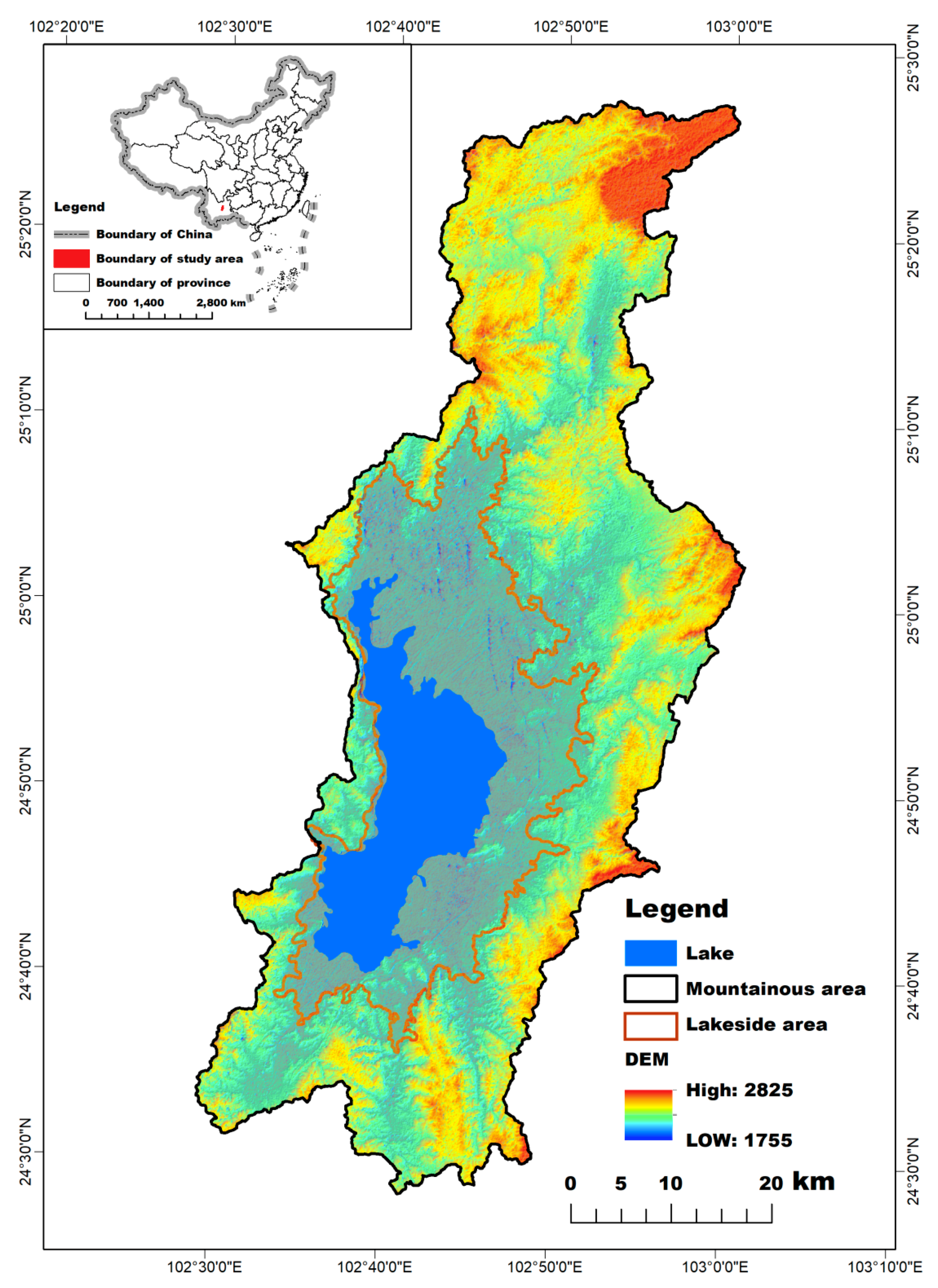
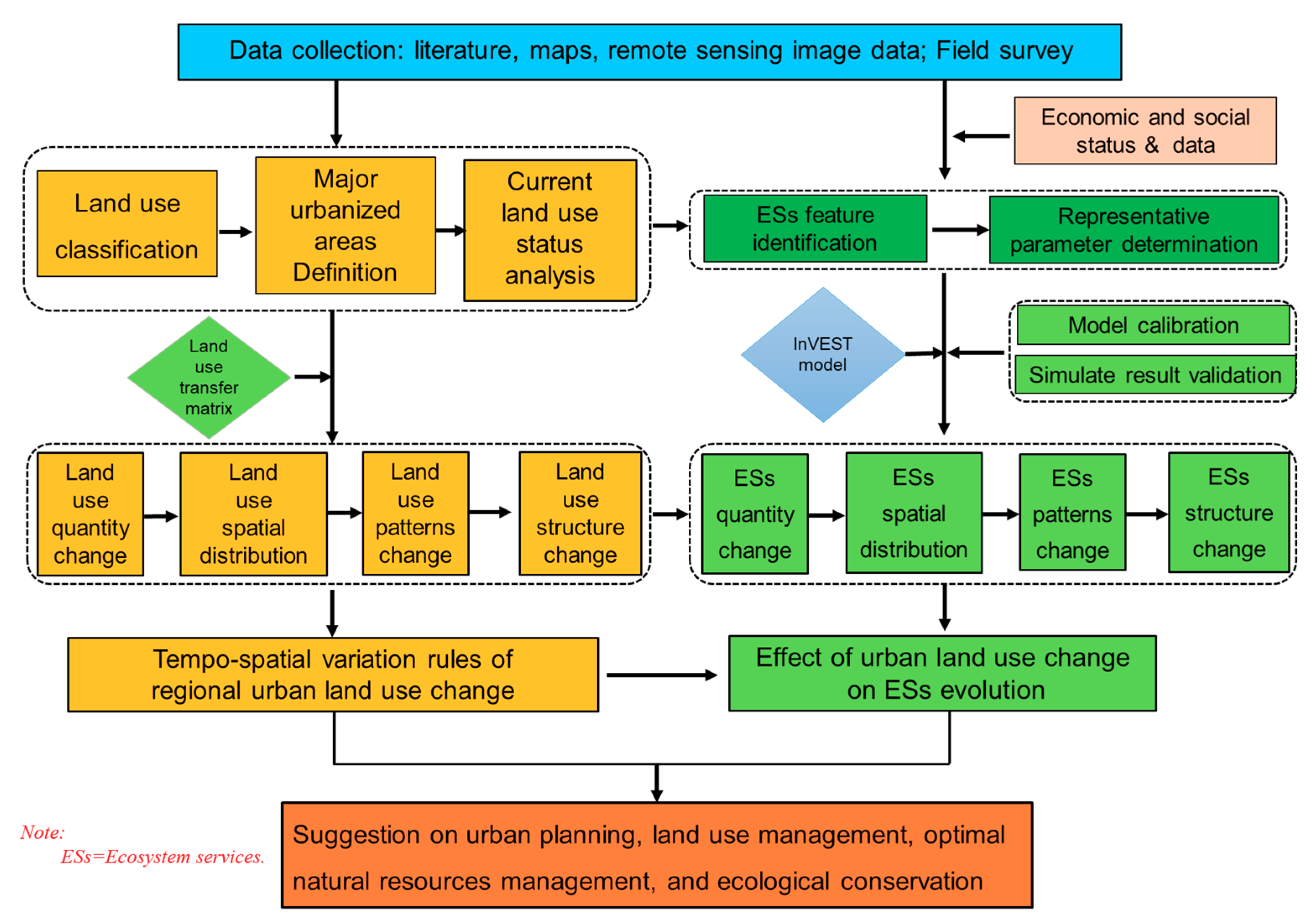
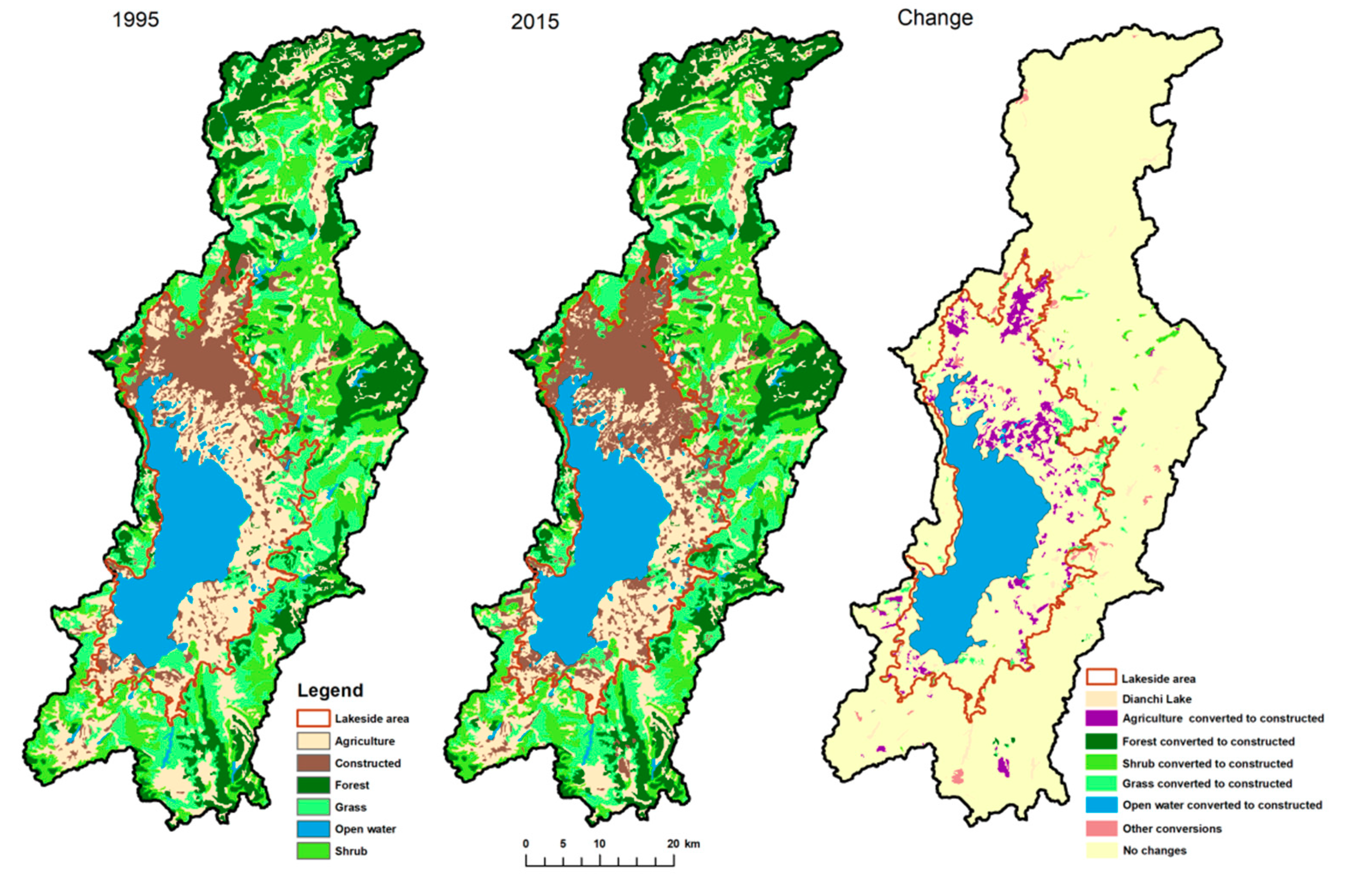
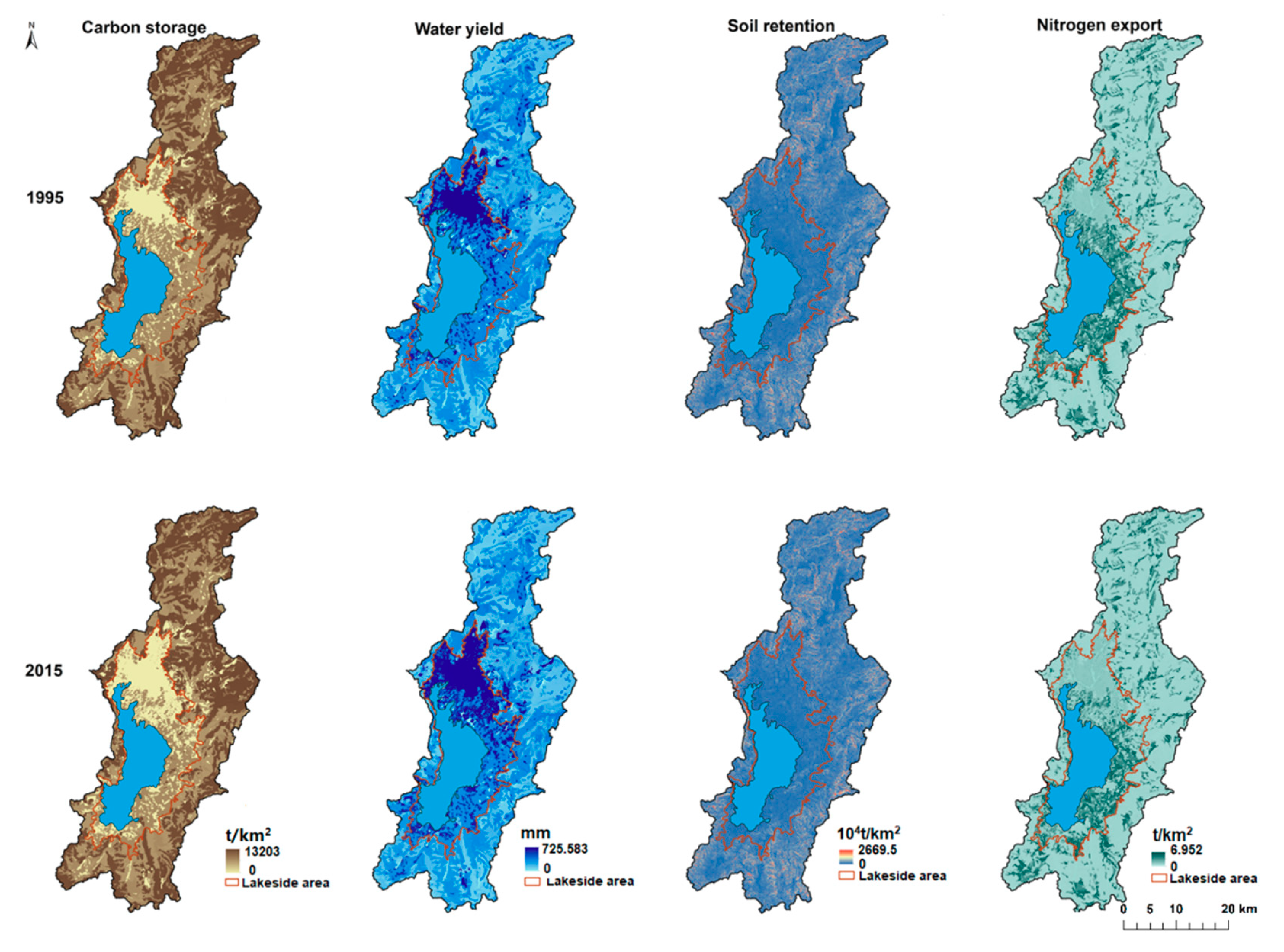
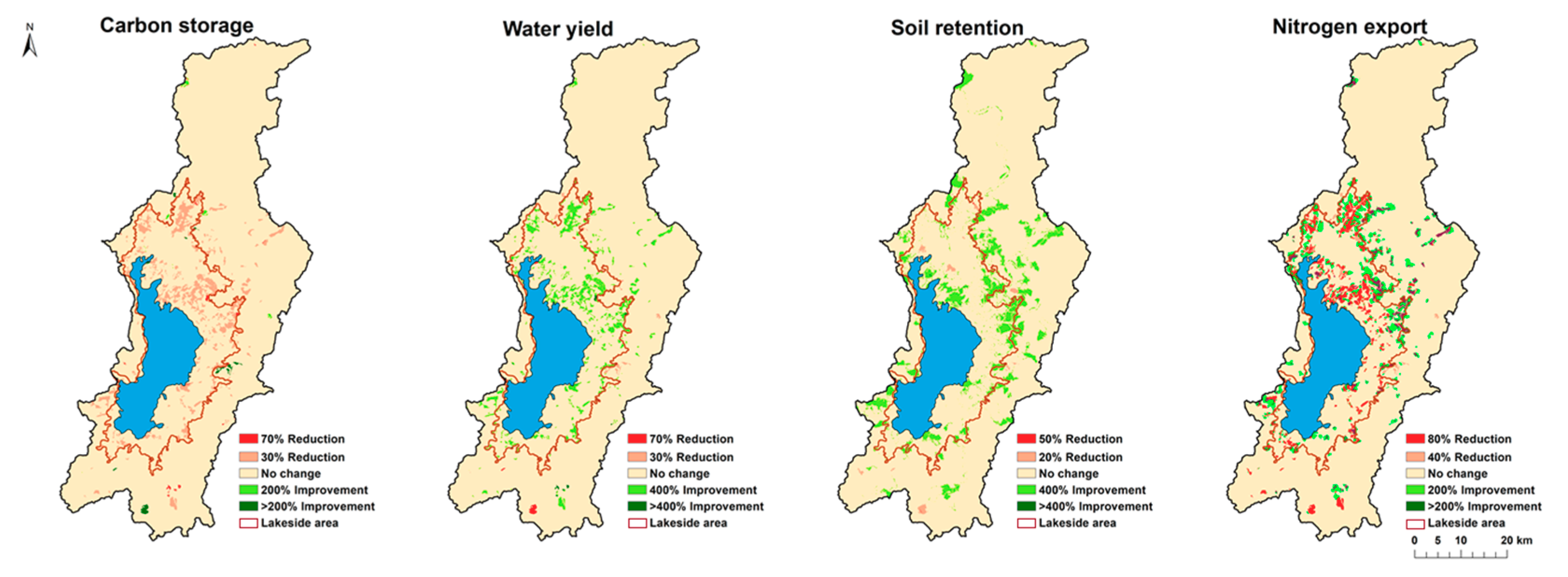
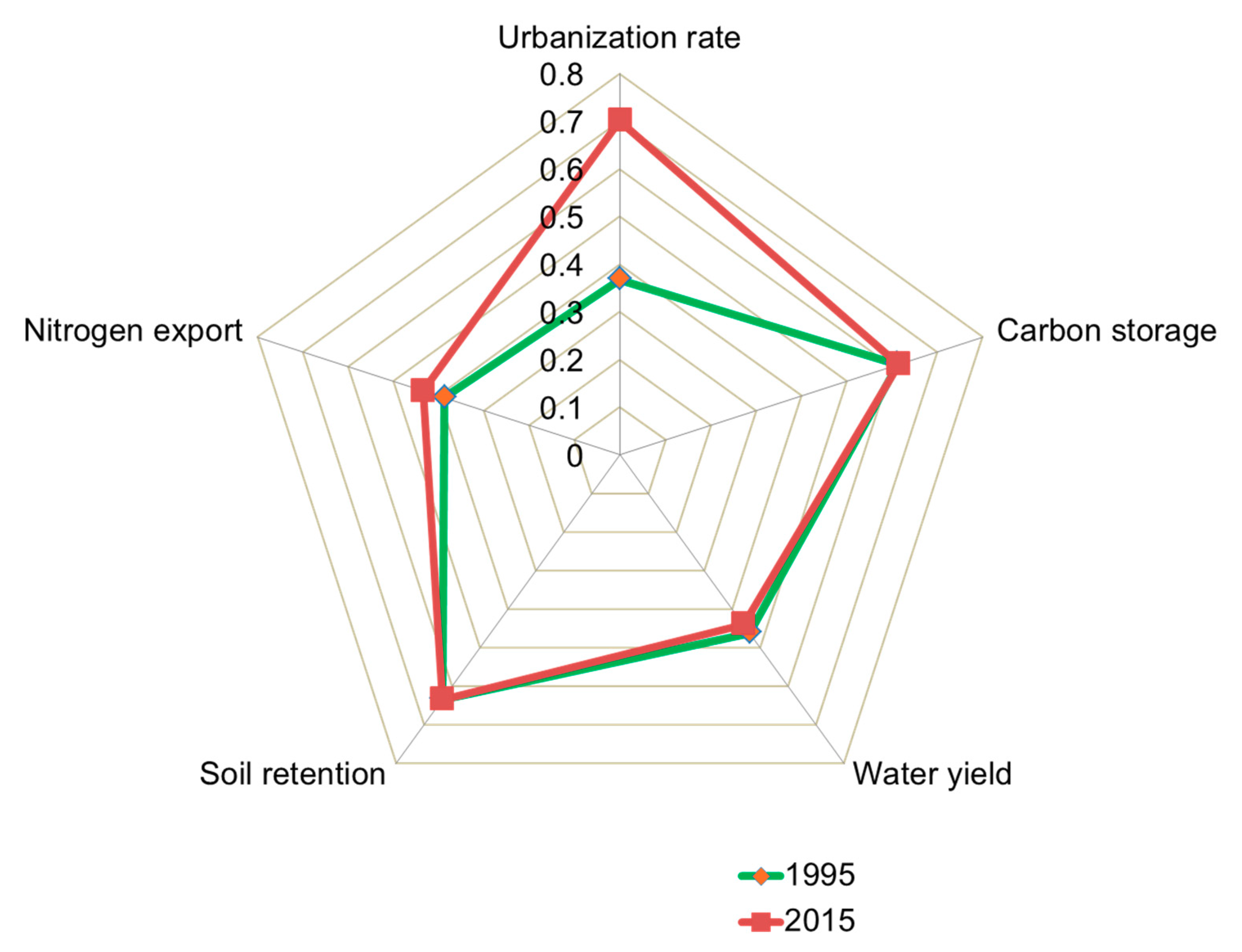
| Area (km2) | Land Type (km2) | |||||||
|---|---|---|---|---|---|---|---|---|
| Grass | Shrub | Constructed | Agriculture | Forest | Open Water | Total | ||
| Whole DLB, 1995 | Grass | 528.98 | 1.13 | 33.99 | 2.38 | 3.22 | 0.09 | 569.78 |
| Grass | 0.76 | 486.96 | 11.31 | 0.49 | 0.28 | – | 499.80 | |
| Constructed | 0.23 | – | 273.50 | 0.05 | 0.08 | 0.04 | 273.89 | |
| Agriculture | 1.79 | – | 87.96 | 631.19 | 2.87 | 0.16 | 723.97 | |
| Forest | 0.07 | – | 2.29 | 0.13 | 509.02 | 0.04 | 511.55 | |
| Open water | – | – | 3.89 | – | 0.03 | 339.58 | 343.50 | |
| Total | 531.83 | 488.08 | 412.94 | 634.24 | 515.50 | 339.90 | 2922.50 | |
| Lakeside area, 1995 | Grass | 41.44 | 0.02 | 24.73 | 0.03 | 0.01 | 0.00 | 66.23 |
| Shrub | 0.01 | 8.94 | 1.73 | 0.15 | 0.00 | – | 10.84 | |
| Constructed | 0.20 | – | 230.30 | 0.04 | 0.08 | 0.00 | 230.62 | |
| Agriculture | 1.22 | – | 78.00 | 248.93 | 0.35 | 0.16 | 328.66 | |
| Forest | – | – | 0.96 | – | 5.62 | – | 6.59 | |
| Open water | – | – | 3.85 | – | 0.03 | 318.83 | 322.71 | |
| Total | 42.88 | 8.96 | 339.57 | 249.15 | 6.09 | 319.00 | 965.65 | |
| Mountainous area, 1995 | Grass | 487.54 | 1.11 | 9.25 | 2.35 | 3.21 | 0.09 | 503.55 |
| Shrub | 0.75 | 478.01 | 9.58 | 0.34 | 0.28 | – | 488.96 | |
| Constructed | 0.03 | – | 43.20 | 0.01 | 0.04 | 43.28 | ||
| Agriculture | 0.57 | – | 9.96 | 382.26 | 2.52 | – | 395.31 | |
| Forest | 0.07 | – | 1.33 | 0.13 | 503.40 | 0.04 | 504.97 | |
| Open water | – | – | 0.04 | – | – | 20.75 | 20.79 | |
| Total | 488.96 | 479.12 | 73.38 | 385.08 | 509.41 | 20.90 | 1956.85 | |
| Basin Partition | ESs | Carbon Storage | Water Yield | Soil Retention |
|---|---|---|---|---|
| Lakeside area | Water yield | 0.463 **, a | – | – |
| 0.433 **, b | – | – | ||
| Soil retention | 0.210 ** | 0.166 ** | – | |
| 0.209 ** | 0.168 ** | – | ||
| Nitrogen export | 0.443 ** | 0.169 ** | 0.103 * | |
| 0.419 ** | 0.089 ** | 0.1 | ||
| Mountainous area | Water yield | −0.610 ** | – | – |
| −0.597 ** | – | – | ||
| Soil retention | 0.108 * | −0.1 | – | |
| 0.100 * | −0.1 | – | ||
| Nitrogen export | −0.275 ** | 0.403 ** | −0.1 | |
| −0.270 ** | 0.348 ** | −0.1 | ||
| Whole basin | Water yield | −0.281 ** | – | – |
| −0.303 ** | – | – | ||
| Soil retention | 0.176 ** | −0.071 * | – | |
| 0.178 ** | −0.082 ** | – | ||
| Nitrogen export | −0.171 ** | 0.272 ** | 0.002 | |
| −0.159 ** | 0.212 ** | 0.013 |
Publisher’s Note: MDPI stays neutral with regard to jurisdictional claims in published maps and institutional affiliations. |
© 2021 by the authors. Licensee MDPI, Basel, Switzerland. This article is an open access article distributed under the terms and conditions of the Creative Commons Attribution (CC BY) license (https://creativecommons.org/licenses/by/4.0/).
Share and Cite
Wang, R.; Xu, X.; Bai, Y.; Alatalo, J.M.; Yang, Z.; Yang, W.; Yang, Z. Impacts of Urban Land Use Changes on Ecosystem Services in Dianchi Lake Basin, China. Sustainability 2021, 13, 4813. https://doi.org/10.3390/su13094813
Wang R, Xu X, Bai Y, Alatalo JM, Yang Z, Yang W, Yang Z. Impacts of Urban Land Use Changes on Ecosystem Services in Dianchi Lake Basin, China. Sustainability. 2021; 13(9):4813. https://doi.org/10.3390/su13094813
Chicago/Turabian StyleWang, Ruibo, Xiaojun Xu, Yang Bai, Juha M. Alatalo, Zongbao Yang, Wei Yang, and Zhangqian Yang. 2021. "Impacts of Urban Land Use Changes on Ecosystem Services in Dianchi Lake Basin, China" Sustainability 13, no. 9: 4813. https://doi.org/10.3390/su13094813
APA StyleWang, R., Xu, X., Bai, Y., Alatalo, J. M., Yang, Z., Yang, W., & Yang, Z. (2021). Impacts of Urban Land Use Changes on Ecosystem Services in Dianchi Lake Basin, China. Sustainability, 13(9), 4813. https://doi.org/10.3390/su13094813






